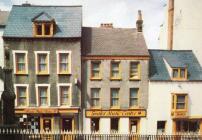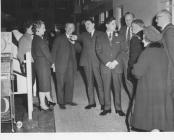Content can be downloaded for non-commercial purposes, such as for personal use or in educational resources.
For commercial purposes please contact the copyright holder directly.
Read more about the The Creative Archive Licence.
Description
Glamorgan (continued)
Image 1:
Drawn by H. Gastineau, engraved by J. Tingle (circa 1800)
Melincourt Waterfall, Vale of Neath.
At this place [Melin Court] the water passes over the verge of a dark precipitous rock, at the height of eighty feet above the spectator, producing one of the most picturesque cascades imaginable, in its descent to the bed of the stream beneath. The surrounding scenery appears in unison with the dignity of the fall; it is romantically wild, rocky, and finely overhung with trees. (Donovan, 1805)
Image 2:
Unknown artist (circa 1750)
Neath Castle.
The poor remains of Neath castle, an ancient fortress built by Richard de Greenfield for the defence of the place in the reign of William Rufus, stands in part concealed by the houses on one side of the town. The area within the castle walls appears overgrown with trees, in the midst of which arises to a vast height, a solitary fragment of one of the old walls, which being perfectly detached from the rest of the ruin, assumes a singular appearance. (Donovan, 1805)
Image 3:
Donovan (1805)
Neath Abbey.Before this edifice fell into decay, it was esteemed the finest monastic pile of building in the Principality. Leland, who visited this place about the time of the dissolution, calls it "the fairest abbey in Wales", and the testimony of the antiquary is certainly worthy of our credit: his evidence is confirmed by the appearance of the ruin which still retains abundant proof of the former magnitude and grandeur of the building. The figures delineated in the foreground, represents the manner in which the coal is conveyed, with facility, from the pits to the smelting houses. The vehicles in which this fuel is carried, are called dram waggons. Four or five of these heavy machines, linked together, and filled with coal, are drawn with the greatest ease by means of a single horse upon the rail roads, constructed for the purpose, and only require the assistance of one man for their management. (Donovan, 1805)
Image 4:
Unknown artist (circa 1800)
Neath Abbey.
Image 5:
Drawn by H. Gastineau, engraved by W. Wallis (circa 1800)
The Crypt, Neath Abbey.
Image 6:
Hand-coloured wood engraving by unknown artist, in The Illustrated London News (1st August 1863)
Opening of the Swansea and Neath Railway. The first train passing Neath Abbey station.
Image 7:
Hand-coloured wood engraving by unknown artist, in The Illustrated London News (1st August 1863)
Neath Railway (detail).
Image 8:
Donovan (1805)
Pennarth Castle.Pennarth castle stands at the extremity of a sandy heath, rising upon the verge of a rocky cliff on the side of a small valley, through which a trifling stream is observed to flow, in its direction from the hills about five miles off, towards the bay of Oxwich, the latter of which lies immediately below to the southward of this ruin. The country people have a curious idea concerning this ruin. They say it was never built with hands, but raised in a night by the power of enchantment, and believe it still to be the lurking place of a particular tribe of fairies. Historians attribute the building to Richard, and earl of Warwick. (Donovan, 1805)
Image 9:
Donovan (1805)
Mumbles Lighthouse.Seen through a singular, natural excavation, formed in one of the contiguous rocks, apparently by the violence of the sea; an opening of small dimensions, but admirably picturesque. The light-house rock is insulated from the extremity of the promontory, and is only accessible on foot at low water, and even then the ascent is not perfectly easy. (Donovan, 1805)
Image 10:
Unknown artist (created circa 1750, published circa 1800)
Swansea Castle.
In the old Welsh chronicles Swansea castle is called the castle of Aber-tawe, in allusion to its situation near the entrance of the Tawe river. This is an ancient fabric, having been erected by Henry Beaumont, earl of Warwick, who obtained a grant of the lands of Gower from William Rufus, in the year 1090. This castle forms a conspicuous feature in the appearance of the town as it occurs to view from the old road to Neath. In the town itself the building is too much encumbered by the adjacent houses to be seen to any advantage. It is still partly habitable, one portion of it being fitted up for the accommodation of the poor of the parish, and another, with recent additions, for the jail. A lofty tower remains likewise, which we ascended by means of a ruinous winding staircase, and obtained from thence a comprehensive view of the environs of Swansea. (Donovan, 1805)
Image 11:
Unknown artist (circa 1800)
Entrance to Swansea Harbour.


























Do you have information to add to this item? Please leave a comment
Comments (0)
You must be logged in to leave a comment